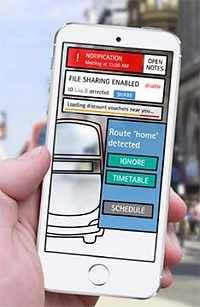Commentary
All Aspects Of Mobility Now Key Driver Of Digital Growth In Companies
- by Steve Smith , Staff Writer @popeyesm, March 10, 2014
 The
enterprise “gets” mobile now. Maybe there is no great surprise in that. After all, the smartphone really was adopted first by corporate executives in need of portable computing. The
general consumer was not the one buying those clunky and early Windows-driven, antenna-popping bricks of yesteryear. And so mobility is not news to the major corporation. Among these executives, 44%
said they already have an enterprise-wide mobility strategy, and another 43% say theirs is directed at specific business units. Only 11% admit they are still working on a strategy, while a mere 2%
consider mobility irrelevant to their company.
The
enterprise “gets” mobile now. Maybe there is no great surprise in that. After all, the smartphone really was adopted first by corporate executives in need of portable computing. The
general consumer was not the one buying those clunky and early Windows-driven, antenna-popping bricks of yesteryear. And so mobility is not news to the major corporation. Among these executives, 44%
said they already have an enterprise-wide mobility strategy, and another 43% say theirs is directed at specific business units. Only 11% admit they are still working on a strategy, while a mere 2%
consider mobility irrelevant to their company.
But what is really interesting about the new Accenture mobility study of 1,475 executives across 10 industries in 14 countries? These guys say their companies are not only “getting mobile,” in that sort of generalized “yeah-we-have-our-eye-on-it way.” This time they are telling researchers that their interest in emerging mobile platforms is detailed and deep. What stands out to me in this report is how mobility in all its aspects, especially technologies that also will be driving mobile marketing, are of keen interest for adoption within the company.
Mobility is bigger than Big Data, that other trending buzzword of the moment, with 77% of respondents saying mobility is among their top five priorities, while analytics follows at 72%. Add to that: connected devices are third with 65%, above cloud computing (62%) and social (61%)
But it is the interest of these executives in emerging mobile platforms that is most impressive. The survey finds that 39% believe they will consider in their digital/IT agenda in the next three years wearable devices like smartwatches and exercise devices. Almost as many (38%) expect to be looking at innovative UIs like AR, voice recognition and motion or gesture-based interface. Geo-fencing and location-based services are expected to be part of the mix for 35% of companies, and 30% expect to be exploring NFC solutions.
To be sure, the enterprise interest in mobility has much more to do with internal efficiencies. Connected vehicle solutions and connected building solutions are the top priorities because things like fleet management and plant operations are where the money can be saved. But almost as many consider connected home and wearable solutions relevant to their businesses.
The importance of enterprise IT attitudes toward emerging mobile platforms is a matter of acceptance and recognition. Years ago and much earlier in the mobile marketing game, a few smart agencies focused on helping their clients implement mobile solutions internally as a way to streamline operations and employee communications. They understood that adoption of mobile solutions inside the company would eventually help drive its use for their consumer-facing products and interactions. It is a long-standing but under-appreciated truism that when it comes to digital investment, familiarity breeds investment. Back in the early and mid-2000s, I recall digital ad salespeople arguing that the real turning point in online marketing investment came when PCs started showing up on executive desks. When the decision-makers in a corporation were themselves experiencing the power and relevance of a technology on a day-to-day basis, then solutions providers didn’t have to sell them on the relevance of the platform anymore. The platform was selling itself.
That corporate IT and other top executives are already seeing the relevance to them in AR, NFC, connected devices, wearables, LBS and voice/gesture technologies means that fewer of these platforms will require defense and explanation as they begin popping up on marketing plans.



